The Coastal-Pro MACV has proved its value in a variety of demanding conditions. With uses ranging from rescue craft on frozen Finnish rivers to UXO detection in Kuwaiti oil pits, it’s provided a platform for commercial and utility work such as accessing island homes, intertidal crew transfer on civil engineering projects, geotechnical survey platform and regular TV and media work. In an intertidal area, there is simply no better way to travel. It is safe, fast and cost effective. When built to MACV specification, this hovercraft includes the following upgrades as standard.

SEATING CAPACITY
3-4 people

ENGINE
Powered by Vanguard V-Twin engine

SPEED
35mph at 20mpg

At just 74dbA, the award-winning Coastal-Pro is probably the quietest production hovercraft available in Europe!
The Coastal-Pro has proved its value in a variety of demanding conditions. Used as rescue craft on frozen Finnish rivers, to UXO detection in Kuwaiti oil pit, it’s provided a platform for commercial and utility work such as accessing island homes, intertidal crew transfer on civil engineering projects, geotechnical survey platform and regular TV and media work.
In an intertidal area, there is simply no better way to travel. It’s safe, fast and cost effective. When built to MACV specification, it includes the following upgrades:
Stronger hull for the knocks and bangs inevitable in commercial work.Fire resistant resin in engine bay area.Steering lock for emergency use.Manual bilge pump (in addition to electric pump).Navigation lights, all-round white light, 70W lighting bar.Seats modified for mud-escape.Certification – manufacturers a build certificate.Additional fire extinguisher.Lifelines.Compass.VHF radio and antenna.Anchor & Rope.Paddle/boat hook.
And here’s some good news. Following publication and adoption of the MCA 'Hovercraft Code of Practice CoP-23) small hovercraft are able to operate in limited commercial roles without a requirement for coding (see the Code for details of operating areas and crewing requirements) This saves a considerable cost and of course, whilst there is a specification which must be met, the MACV designation will be applied to BHC which are built and certified to HCoP commercial standards.

As of June 2014, and following two years of discussions with the MCA, we can now provide bespoke Marine Air Cushion Vehicles (MACV’s) for hire without a requirement for the craft to be commercially coded.



Stronger hull for the knocks and bangs inevitable in commercial work
Fire resistant resin in engine bay area
Steering lock for emergency use
Additional electric bilge pump
Navigation lights, all-round white light, 70W lighting bar
Seats modified for mud-escape
Certification – manufacturers build certificate
Additional fire extinguisher
Twin 12v batteries with changeover/isolator switch
Lifelines
Compass VHF radio and antenna Anchor & Rope Lifebuoy mounted on duct Paddle/boat hook USB port Chrome kit
And here is some good news. Following publication and adoption of the MCA 'Hovercraft Code of Practice CoP-23, small hovercraft are able to operate in limited commercial roles without a requirement for coding (see the Code for details of operating areas and crewing requirements). This saves a considerable cost and of course, whilst there is a specification which must be met, the MACV designation will be applied to BHC craft which are built and certified to HCoP commercial standards.
Performance
Commercial Coastal Pro
The Coastal-Pro MACV has proved its value in a variety of demanding conditions.
Further Info & Tech Specs
Full breakdown of everything you need to know about the Coastal Pro MACV.
Engine & Transmission
The Coastal-Pro uses two 4 stroke engines, one for lift, one for thrust. The thrust engine is a Vanguard 37bhp and the lift a 23bph version. Both, of course, are electric start. The engines both run at low maximum revs, approx. 3800rpm for the thrust engine and 3500rpm for the lift. It can often cruise in decent conditions at 2800rpm. This means noise is low and economy excellent.
Both engines are modified and ‘hoverised’ for marine use. Maintenance is very simple and there are dealers and service centres all over the world for spares and advice. Simple and robust – there’s nothing glamorous or high about these engines which means they’re reliable and easily serviced and repaired by any competent mechanic.
The excellent performance of the Coastal-Pro doesn’t come from big horsepower. It doesn’t need to. The lightweight, reinforced build, ‘clean’ fan ducts and optimised fan setup means that it easily outperforms some hovercraft with two or three times its horsepower. In hovercraft design, weight and efficiency are everything. Lower power allows lower noise levels, more reliable transmission and machinery systems, increased range (less fuel requirement) and lower operating costs.
Hull, Buoyancy & Skirt
The Coastal-Pro is manufactured from a fiberglass hull, by our team of highly specialised laminators. All hovercraft need to be built to a weight to perform properly, so our hulls are reinforced with Kevlar & Core materials in vulnerable or structural areas, whilst an intelligent lay-up saves weight in less critical locations. The surface is finished with an impregnated gel coat, rather than being sprayed afterwards. This gives a fade-free, very shiny & smooth finish to the hovercraft, which means it washes off easily, whatever you cover it in!
Inside the hull are sections of encapsulated closed-cell foam which, as well as providing buoyancy, also shapes the air within the plenum chamber for best efficiency and performance. The buoyancy provided is adequate to keep the hovercraft afloat, even should it be fully swamped with a full payload aboard.
Hovering approx. 30cms (12ins) in the air on its ‘finger’ or segmented skirt, powered by it’s independent lift system, the Coastal-Pro flies with great ease. This efficiency means that just the skirt ‘tips’ are touching the ground and as a result of this almost frictionless seal, performance is improved, and wear reduced. Skirt wear is something that first-time owners and commercial operators are often concerned about but in actual fact, is simply not an issue. Think of the skirt like the tyres on a car. How you drive it and the surface you use it on will effect how long it lasts. The Coastal-Pro skirt comprises 83 individual segments which has enormous advantages over a ‘bag/loop’ design used on large hovercraft. Any damage or excessive wear is localised, and quickly and easily repaired – it takes just a couple of minutes to change a segment. Being individual segments means the skirt works more effectively and can seal more fully on the land or water which gives the best possible lift and effortless performance. The chances are that you'll do whole days cruising or work without needing to change a segment. As a guideline, we usually find that most recreational customers using their hovercraft on a mix of land, sand, mud and water will get around two years wear from a skirt, and will use a dozen or so spares during that time. New skirt segments are inexpensive and can even be repaired if preferred.
UK Commercial Operations
In 2015, the Maritime & Coastguard Agency published the Hovercraft Code of Practice (HCoP) which sets out standards for the commercial operation of hovercraft in UK Waters. For passenger carrying and larger hovercraft, this is great news, as there is finally a method allowing operators to code them without needing to comply with the High-Speed Code, which was effectively impossible for most hovercraft of less than 8m.
What was even more warmly received was the MCA’s introduction of a new category of hovercraft called ‘Ultralight’ into which both the Coastal-Pro and Coastal-Pro XL fall.
When operating in-land (such as giving rides at a show/event, driving events businesses or on private lakes & ponds) there is no requirement to meet MCA standards or restrictions on operations. The issue has always been with operations in Intertidal areas, the coastline & estuaries – ie any tidal/salt water operations where the MCA or river/harbour authorities have control.
The Ultralight category allows hovercraft to operate in a limited commercial capacity in a marine environment where no fare-paying passengers are being carried, so it’s aimed at such operations as:
Intertidal Survey.Geotechnical Survey.Geosurvey.Environmental Services.Crew Transfer.Bird Counts.Mapping.Water Sampling.Standby & Safety.
The key point here is that no fare-paying passengers can be carried. An operator can therefore provide contracted hire-services for crew transfer where crew are briefed and engaged ‘in the operation of the vessel. What it does not allow is for an operator to set up giving rides on Blackpool Sands where passengers are carried.
RestrictionsHovercraft must weigh no more than 500kgs unladen weight all BHC hovercraft meet this.Maximum of 4 persons on board.Daylight hours and in good visibility only.Restricted to Category 6 Waters, no more than 0.5 miles from the shore (beyond categorised waters) or in areas which are not capable of being navigated by conventional ships within 3 miles of a safe landing place or within one mile of an appropriately certified support boat.Maximum significant wave height of 0.3m.Suitably qualified crew.Hovercraft prepared to Hovercraft Code standards.Other Requirements
An Ultralight is operated as work equipment under Provision and Use of Work Equipment Regulations (PUWER). The owner/operator is responsible for ensuring that suitable risk assessments have been carried out, that appropriate maintenance has been completed and that appropriate training and qualifications etc. are in place in accordance with relevant land or sea-based health and safety regulations.
The code sets out the standards (see info box) and the MACV Hovercraft is built to include such equipment as required. The following (not included but can be supplied) is also required.
Chart or plotter for area of operations.Lifejackets for all crew.2 Red Flares / 2 Smoke Flares.Signals Table.
Crewing requirements: Skipper must be qualified to RYA Powerboat II standard, commercially endorsed and have 25 hours instruction/experience.
Summary
The smallest hovercraft are now pieces of work equipment and therefore there is technically no MCA standards to meet for commercial work. Rather, PUWER rules apply. However, it is very likely the local authority will demand the hovercraft is built, prepared and manned to the standards of the code, in order to ensure safe operation.
Additionally, if there was an accident or incident and the operator was found to have failed in his duty to operate safely (for which the Hovercraft code provides the standards) then he may well be open to prosecution.


